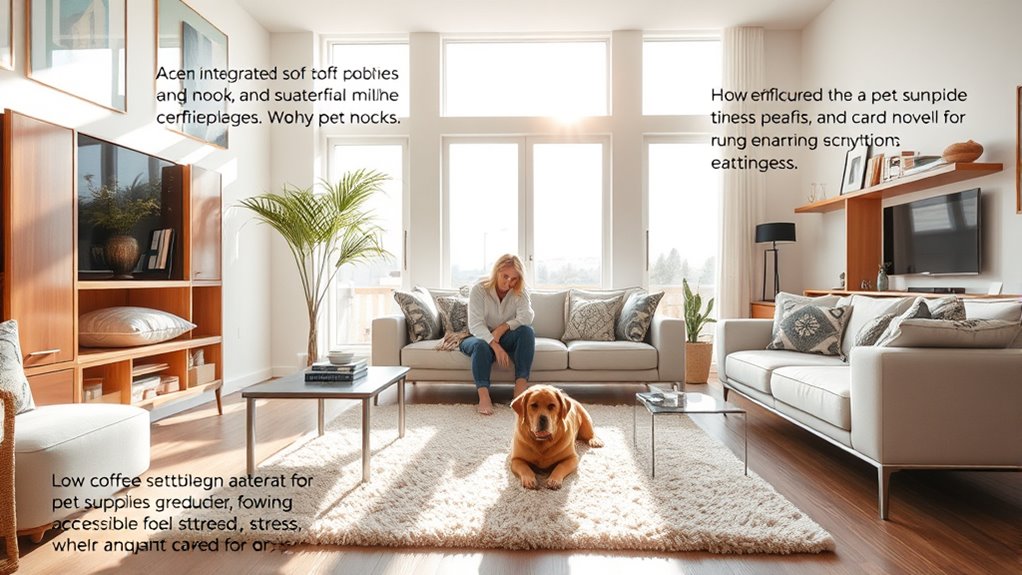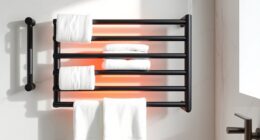Creating a pet-friendly design helps you build a safe, organized space that reduces daily chaos and your stress as a caregiver. Use open areas for your pet’s free movement and designate zones for eating, sleeping, and play. Choose durable, easy-to-clean materials and hide hazards like cords and chemicals. Incorporate calming elements to promote relaxation and safety. If you want to learn how to make your home both welcoming and stress-free for you and your pet, keep exploring these tips.
Key Takeaways
- Create open, clutter-free spaces for easy pet movement and navigation.
- Use durable, washable materials to simplify cleaning and reduce stress from stains or odors.
- Install safety features like covered cords and secure trash cans to prevent accidents.
- Incorporate calming elements such as soft lighting and soothing scents to promote relaxation.
- Design designated zones for eating, sleeping, and play to minimize chaos and enhance harmony.

Have you ever wondered how to make your home more welcoming for your furry friends? Creating a pet-friendly space isn’t just about adding a few cozy corners or choosing the right furniture; it’s about designing an environment that minimizes your stress while keeping your pet comfortable and safe. When you plan with your pet’s needs in mind, you simplify your daily routines and reduce common frustrations like messes, accidents, or safety hazards. This approach helps you enjoy your time together without constantly worrying about potential mishaps or chaos.
Start by thinking about layout. You want open, accessible areas where your pet can move freely without bumping into furniture or getting stuck. Avoid cluttered spaces that make it hard for your pet to navigate, which can lead to accidents or injuries. Incorporate designated zones for eating, sleeping, and play. For example, set up a cozy corner with a soft bed in a quiet part of the house, so your pet has a safe retreat. By giving your pet clear, designated spaces, you prevent them from wandering into unsafe areas or knocking over items, which can cause stress for you and your pet alike.
Create open, clutter-free zones with designated areas for your pet’s comfort and safety.
Another important aspect is choosing durable, easy-to-clean materials. Carpets can trap fur and dirt, making cleaning a hassle, so consider hardwood, tile, or laminate flooring. These surfaces are easier to wipe down and maintain. For furniture, look for pet-resistant fabrics or slipcovers that are washable. This way, if your pet has an accident or sheds fur, you can clean it quickly, reducing the stress of dealing with stains or odors. Incorporating washable rugs and furniture covers also makes your space more adaptable and less prone to permanent damage, giving you peace of mind. Additionally, understanding the importance of safety features in pet-friendly design can significantly reduce potential hazards and emergencies.
Safety features are vital in pet-friendly design. Use cord covers or hide electrical cords behind furniture to prevent chewing. Install secure trash cans with lids to keep your pet from rummaging through garbage. Keep hazardous substances—like cleaning supplies or medications—out of reach. Window screens should be sturdy and well-fitted to prevent escapes or falls. These small adjustments considerably cut down on emergency trips to the vet and give you peace of mind that your pet is safe while you’re busy with daily activities.
Finally, think about your own comfort. Incorporate calming elements like soft lighting, calming scents, or soothing music to create a peaceful environment for both you and your pet. When your home feels harmonious, your stress diminishes, and your pet feels more secure. Pet-friendly design isn’t just about protecting your furry friends; it’s about creating a space that promotes harmony, reduces chaos, and makes caring for your pet a joy instead of a source of constant worry.
Frequently Asked Questions
How Can Design Reduce Pet-Related Caregiver Injuries?
You can reduce pet-related caregiver injuries through thoughtful design by incorporating non-slip flooring, which prevents falls. Use low, easy-to-reach pet features to minimize strain and avoid lifting injuries. Install secure, sturdy enclosures for pets and provide ample space for safe movement. Well-placed handrails and ergonomic furniture also help caregivers handle pets comfortably, reducing the risk of injuries while ensuring both pet and caregiver safety.
What Materials Are Safest for Pet-Friendly Home Features?
Opt for non-toxic, durable, and easy-to-clean materials like natural hardwood, tile, and stainless steel. These materials resist scratches, withstand pet wear and tear, and prevent harmful chemical exposure. Use pet-safe finishes and sealants that are free from harmful VOCs. Select soft, non-slip rugs and padded furniture to guarantee safety and comfort. Prioritize smooth surfaces and rounded edges to minimize injuries and create a welcoming, secure environment for both pets and caregivers.
How Does Pet-Friendly Design Impact Property Value?
Pet-friendly design can boost your property value by attracting pet owners who prioritize safe, convenient spaces. When you incorporate durable flooring, pet-proof fencing, and easy-to-clean surfaces, your home appeals to a broader market. These features demonstrate thoughtful planning, making your property stand out. As a result, you’ll likely see increased interest, faster sales, and higher offers, all while creating a welcoming environment for pets and their owners.
Are There Specific Colors That Calm Pets and Reduce Stress?
Colors like soft blues, gentle greens, and warm neutrals act like a calming breeze for pets, reducing their stress levels. You’ll notice calmer behavior and less anxiety when you incorporate these hues into your space. Think of these shades as a peaceful retreat where your pets feel safe and relaxed. Choosing the right colors isn’t just about aesthetics; it’s about creating a soothing environment that benefits both you and your furry friends.
How Can Design Accommodate Multiple Pets’ Needs Simultaneously?
You can design multi-pet spaces by creating separate zones for eating, sleeping, and playing, ensuring each pet has its own territory. Use barriers or furniture to provide visual and physical boundaries, reducing conflicts. Incorporate versatile furniture that accommodates different sizes and activity levels. Maintain clear pathways and good airflow, and select calming colors to promote relaxation. This approach helps meet each pet’s needs while minimizing stress for everyone.
Conclusion
By incorporating pet-friendly design into your space, you create a calming environment for both your pet and yourself. Remember, a house that’s welcoming to your furry friend is a home that eases caregiver stress. As the saying goes, “A happy pet makes a happy home.” When you prioritize comfort and functionality, you build a sanctuary where everyone feels relaxed and loved. Start making those changes today—you and your pet will thank you for it.









